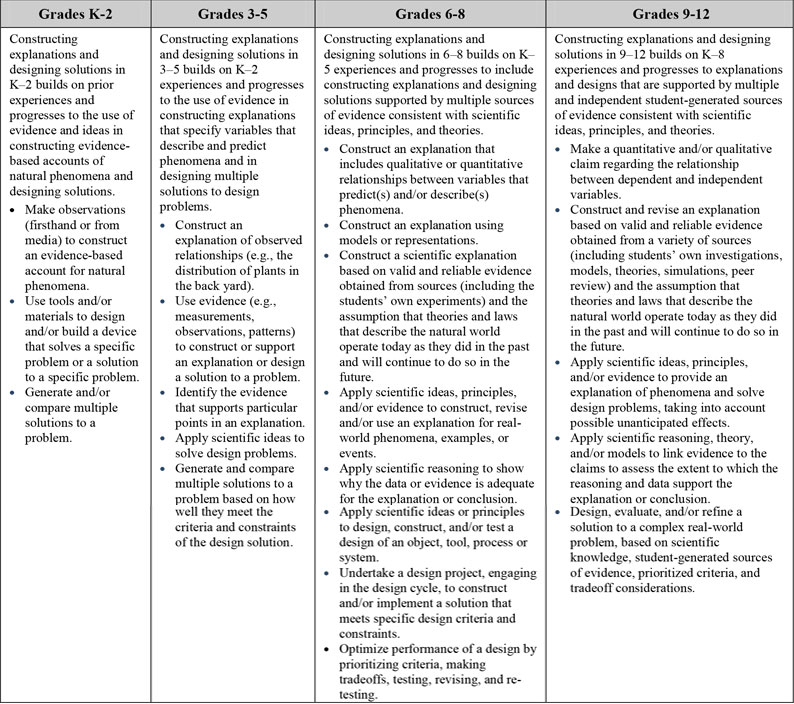Science
The goal of science is the construction of theories that can provide explanatory accounts of features of the world. A theory becomes accepted when it has been shown to be superior to other explanations in the breadth of phenomena it accounts for and in its explanatory coherence and parsimony. Scientific explanations are explicit applications of theory to a specific situation or phenomenon, perhaps with the intermediary of a theory-based model for the system under study. The goal for students is to construct logically coherent explanations of phenomena that incorporate their current understanding of science, or a model that represents it, and are consistent with the available evidence.
Engineering
Engineering design, a systematic process for solving engineering problems, is based on scientific knowledge and models of the material world. Each proposed solution results from a process of balancing competing criteria of desired functions, technological feasibility, cost, safety, esthetics, and compliance with legal requirements. There is usually no single best solution but rather a range of solutions. Which one is the optimal choice depends on the criteria used for making evaluations. (Framework, p. 52)
See A Framework for K-12 Science Education, 2012, p. 67 for the entire text for Practice 6: Constructing explanations and designing solutions.
In the video below from BozemanScience.com, Paul Andersen explains how scientists modify theories by constructing explanations. He also discusses the cycle of design used by engineers to solve problems. He starts by defining a theory as a well-established explanation of a phenomenon that is refined over time.
For more, refer to the Webinar on Constructing Explanations and Designing Solutions from the National Science Teachers Asssociation (NSTA) Learning Center.
Constructing Explanations & Designing Solutions Progression through Gradebands:

Progression from NGSS Appendix F pgs. 11-12.
Activities
Four Conceptual Change Activities are included to help teachers and students Confront Beliefs:
- Constructing Explanations Activity #1: Rope Tube
- Constructing Explanations Activity #2: Balloons & Skewers
- Designing Solutions Activity #1: Rope Tube
- Designing Solutions Activity #2: Pringles Potato Chip Challenge
Also refer to Student Work in the Practice for real-life examples of how MPRES teachers have applied this Practice.
The purpose of the activities is to engage teachers in the Practice of Constructing Explanations and Designing Solutions. The emphasis is NOT on the activity itself, but rather the conceptual change related to the Practice. Consumers of this Toolkit are reminded to not get wrapped up in the activity, but rather continually reflect on the conceptual nature of the Practice to gain deeper understanding.
Since the activities are NOT lesson plans, in some cases only a brief explanation of the activity has been provided. Professional development facilitators should encourage learners to direct their own investigations and intervene only as needed to redirect.
To facilitate conceptual change throughout each activity, you should consider the following questions. These questions are also repeated at key points in each activity to assist you.
Awareness Questions:
- From the background information, what new awareness do you have about constructing explanations & designing solutions?
- How does this practice support constructing explanations & designing solutions?
- In a 3 Dimensional classroom, who do you think needs to be constructing explanations & designing solutions?
- What questions did the background information raise for you?
Expose Belief Questions:
- What are your current beliefs about the constructing explanations and designing solutions practice?
- What beliefs do you have from prior knowledge, education or professional development regarding this practice?
- How well do you feel you meet the expectations of this practice as a teacher?
Debrief activities by focusing on the conceptual understanding of the practice using the prompts (Resolving Belief Questions, Extend the Concept Questions, and Go Beyond Questions) included on the left side of each activity page.


